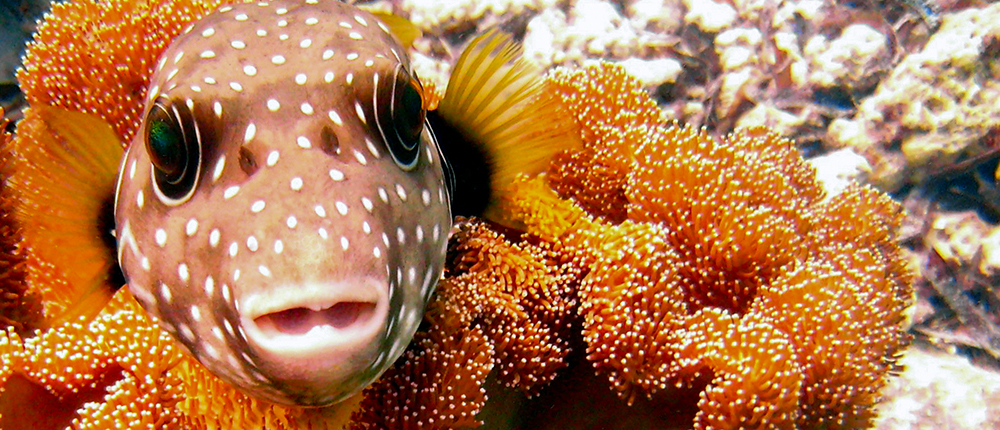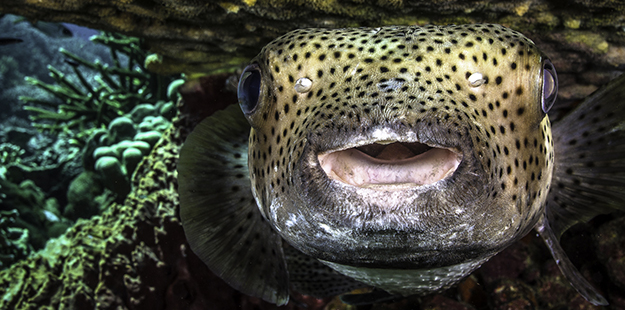Cute and Deadly: Learn about the Puffer Family
There’s more to pufferfish than meets the eye
It’s something you’d expect from a cartoon character: when threatened or stressed, you huff and puff to blow up to twice normal size, then grow spikes. The real-world equivalent of these animated antics takes place on coral reefs around the world every day, and it’s done by members of the Tetraodontidae fish family. They go by many names: pufferfish, balloonfish, blowfish, bubblefish, globefish, swellfish, toadfish, toadies and sea squab. Regardless of what they’re called, these fish are best known for their unique ability to expand and take on the appearance of spiked balloons when they are threatened. The waters of Wakatobi are home to a number of species of puffers. They’re easy to find, and fascinating to watch. Let’s meet some of these inflatable “soccer balls of the sea.”
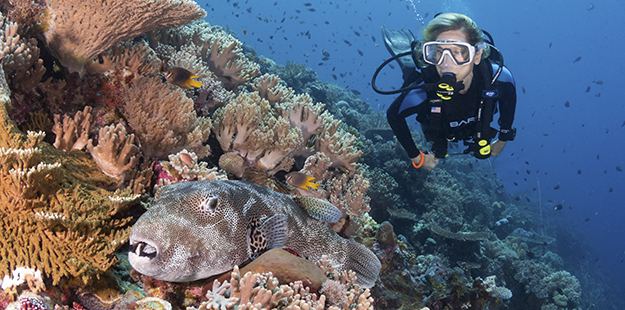
The puffer’s big-eyed, puppy-like appearance make them interesting and evocative subjects for fish watchers and underwater photographers alike. Photo by Walt Stearns
Common, but often overlooked
With more than 120 species in the family, puffers are a common sight on coral reefs around the world. Their slow—some might say clumsy—movements around the reef often seem of little interest to divers, and you might not recognize them when they aren’t all puffed up. Unlike its cousin the porcupine fish, which always shows its spikes, the puffer keeps the onboard armament concealed until it goes into defensive mode. Most of the time, puffers resemble oversized tadpoles, with bulging eyes and an elongated snout that gives them a puppy dog-like appearance.
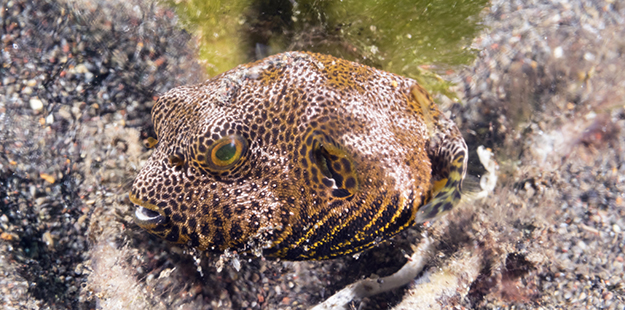
The juvenile Star puffer is solitary, and found around weedy areas near protected inner reefs. They are also found in shallow sand and rubble such as that found at Cheeky Beach, a Pelagian dive site. Photo by Walt Stearns

All puffers have snouts and four large teeth, which are used for crushing the shells of crustaceans and mollusks. Photo by Steve Miller
They come in a wide range of sizes, from the dwarf puffer, which is often less than an inch (2.5 cm) in length, to the starry puffer, which grows up to four feet (1.3 meters). They are scaleless fish and usually have rough to spiky skin. Some sport bold markings and colors to advertise their toxicity, while others have more muted or cryptic coloring to blend in with their environment. All puffers have snouts with four large teeth fused into an upper and lower plate, which are used for crushing the shells of crustaceans and mollusks. The pufferfish diet is made up primarily of invertebrates and algae, and larger fish can sometimes be seen using their hard beaks to crack open clams, mussels and other shellfish.
All puffers have snouts with four large teeth fused into an upper and lower plate, which are used for crushing the shells of crustaceans and mollusks.
One of the more distinctive characteristics of the puffer is the eyes. The relatively large size of their eyes gives puffers a seemingly expressive countenance. But more importantly, it provides sharper vision than most other fish possess—an important survival strategy that allows the puffer to identify potential threats from farther away.
Another ocular advantage puffers have is the ability to move each eye independent of the other, allowing them to scan for threats across a wide range of vision. Both eyes can also be directed forward to provide superior depth perception. Some puffers have eyes with green iridescent layers, positioned to reflect bright sunlight from above while still allowing ambient light from the surrounding environment objects to filter in. It’s the aquatic equivalent of mirrored sunglasses.
Defense strategies
Puffers won’t win any swim races. Their relatively small pectoral and dorsal fins allow them to maneuver around the reef with precision, but don’t provide much speed. But when danger looms, the puffer can get out of the way. The tailfin, which is mainly used as a rudder during uneventful moments, can also provide sudden, short bursts of speed when evasive action is called for. Combined with the puffer’s excellent eyesight, this ability for rapid acceleration allows the puffer to escape many threats without having to resort to visual and chemical defense systems.
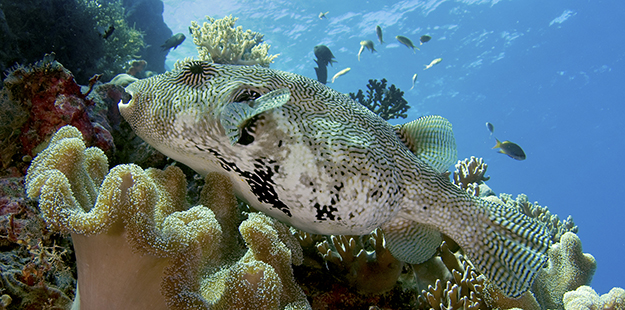
The puffer’s tailfin is mainly used as a rudder during uneventful moments, but can also provide sudden, short bursts of speed when evasive action is called for. Photo by Mark Snyder
When escape isn’t possible, a puffer will revert to plan B, invoking its signature talent for expansion. To inflate, a puffer will swallow water rapidly to fill its highly-elastic stomach, which swells to expand the fish to twice or more its normal size. This size change alone is enough to deter some would-be predators. But at the same time, hidden spikes on the puffer’s skin are raised, transforming this harmless-looking fish into a prickly ball of menace. A hungry predator may suddenly find itself facing an unpalatable pointy ball rather than a slow, tasty fish. But even if a predator manages to get a puffer down its throat, it still may find it got more than it bargained for.


